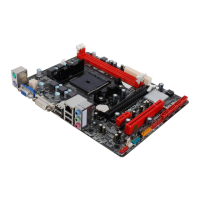A58MDP/A58MLP
27
RAID 1:
Data are stored twice by writing them to both the data
disk (or set of data disks) and a mirror disk (or set of
disks). If a disk fails, the controller uses either the data
drive or the mirror drive for data recovery and continues
operation. You need at least 2 disks for a RAID 1 array.
Features and Benefits
Drives: Minimum 2, and maximum is 2.
Uses: RAID 1 is ideal for small databases or any other application that requires fault
tolerance and minimal capacity.
Benefits: Provides 100% data redundancy. Should one drive fail, the controller
switches to the other drive.
Drawbacks: Requires 2 drives for the storage space of one drive. Performance is
impaired during drive rebuilds.
Fault Tolerance: Yes.
RAID 10:
RAID 10 combines the advantages
(and disadvantages) of RAID 0 and
RAID 1 in one single system. It
provides security by mirroring all data
on a secondary set of disks (disk 3 and
4 in the drawing below) while using
striping across each set of disks to
speed up data transfers.
Features and Benefits
Drives: Minimum 4, and maximum is 6 or 8, depending on the platform.
Benefits: Optimizes for both fault tolerance and performance, allowing for automatic
redundancy. May be simultaneously used with other RAID levels in an array, and
allows for spare disks.
Drawbacks: Requires twice the available disk space for data redundancy, the same
as RAID level 1.
Fault Tolerance: Yes.

